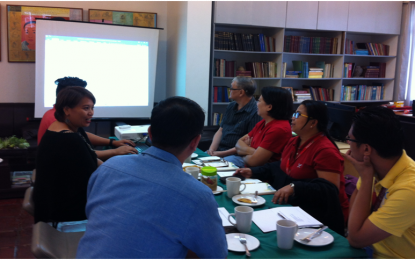
CULTURAL, HISTORICAL SOCIETY. Senior Curator Zarah Escueta (far left) of the “Museo ni Jose Rizal sa Calamba”, or the Rizal Shrine, presides over the meeting for the proposed Calamba City Cultural Heritage and Historical Society at the Rizal Shrine on July 11, 2018. (Photo by Saul Pa-a)
CALAMBA CITY, Laguna – Do you know that this city’s 276-year-old name, which originated from “kalan-banga” (clay stove-pot), may have also been derived from a Sanskrit term “kalamba,” referring to the locally grown aquatic and popular vegetable “kangkong?”
The revelation sparked curiosity after a historical discovery of an ancient Laguna Copperplate Inscription with Indian culturally-influenced “Kawi” writings on its surface, unearthed by a laborer at the mouth of Lumbang River in Barangay Wawa in Lumban, Laguna in 1989.
Historical accounts said the copper plate, dated 900 A.D., is considered the earliest legal written document found in the country suggesting that the “Kawi” script used in Java, Indonesia had traces of inter-cultural exchanges of Sanskrit, old Javanese and old Malay mixed languages used during that time. Laguna could be part of such interchanges with the discovery of the copper plate.
This historical trivia is among the subjects that will be addressed by the soon to be formed Calamba Cultural Heritage and Historical Society (CCHS), which cropped up during preliminary discussions at the exploratory meeting Wednesday afternoon at the Museo ni Jose Rizal sa Calamba (MJRC), or the Rizal Shrine.
Senior Curator Zarah Escueta of the National Historical Commission of trhe Philippines (NHCP) - managed Rizal Shrine briefed conferees from the city Cultural Affairs, Tourism and Sports Development Department (CATSDD), headed by Larissa Malinao, Pansol Tourism and Arts Council director Ruval Magpayo, and Demie S. Borromeo Jr. from the Colegio de San Juan de Letran and other members from the CATSDD- Cultural Promotions and Community Affairs Division Neth Estrada and Sony Aguilar.
“Na encourage po tayo dito sa pinag-usapang (we were encouraged by the proposed) Cultural Heritage and Historical Society (CHHS) as an offshoot of the city’s formation of the city Culture and Arts Council (CAC) as mandated by the (Department of the Interior and Local Government (DILG),” said Escueta adding that the creation of the city’s private sector-led historical society has long been overdue.
She thanked the core group for the first organizational meeting of the historical society. She said she helped organize a similar historical body during her stint in Sto. Tomas, Batangas eliciting inspiration from stakeholders and community.
The conferees also agreed to constitute themselves into an interim body in preparation for the formal assembly slated on Aug. 15 as part of the country’s observance of “History Month,” through Proclamation 339 signed by then President Benigno Aquino III on Feb. 26, 2012.
Per Palace Proclamation 339, the ‘History Month’ observance emphasizes the most significant turning points in Philippine history where the major events occurred in August, winding up to the National Heroes’ Day commemoration on Aug. 27 this year.
Calamba was founded as a pueblo (town) on Aug. 28, 1742.
Escueta said the Cultural Heritage and Historical Society will have its set of officers and board of directors through a constitution and by-laws to be registered with the Securities and Exchange Commission (SEC) as a non-government organization (NGO).
She clarified that the private-led association of individuals, artists, historians, art patrons, history enthusiasts, students, scholars, multi-discipline and humanities course professionals, Knights of Rizal, history resource persons and cultural advocates as well as volunteers, will help the city’s CAC.
The historical association will help the CAC on education, research and development, especially on the CAC’s cultural mapping project including the city’s collective institutional historical memory and preservation of both tangible, intangible or oral histories.
Malinao, for her part part, expressed the city government’s support as “it is about time we have this society” in support of the city government’s cultural mapping, culture and arts projects.
She added that the Laguna College of Business and the Arts (LCBA) has expressed willingness to serve as a history research arm.
According to Malinao, the CAC would be pivotal in the preparation of an annual plan on culture, arts and cultural heritage consonant with the Philippine Development Plan for Culture and the Arts to be integrated in the local development plan.
Among the CAC’s functions include: formulation of programs and recommendations to develop and sustain local cultural and artistic talents, cultural industries, traditional and contemporary arts and crafts and their processes; coordination with appropriate affiliated cultural agencies of the National Commission for Culture and the Arts (NCCA) for the conservation, and monitoring of national cultural properties found in the city;
Establishment of a Local Registry of Cultural Properties; Declaration and maintenance of Local heritage Zones; conduct of cultural events such as cultural festivals, competitions, lectures, seminars and symposia; and identification of such other programs and activities for the promotion of local cultural heritage and arts.
Magpayo of the Pansol Tourism and Cultural Council proposed the core group’s task in setting the directions for the historical society and its complementary role to the CAC.
“Dapat may transition group, parang team muna (it is suggested that a transition group like a team would initiate first) and then choose the CHHS officers from Calamba,” Magpayo said.
Borromeo, on the other hand, cited that Pila, Laguna and Bulacan among other local government units (LGUs) have existing and active historical societies that published their local history and the CHHS formation augurs well for the city, citing the association’s role in the vast scope in history and cultural heritage.
“Pamanang bayan kasi yong cultural heritage at para makilala ang mga pamanang bayan natin ay po-protektahan natin sa pamamagitan ng society na ito (Cultural heritage is a legacy and we have to protect this through the society),” Borromeo said. (PNA)
